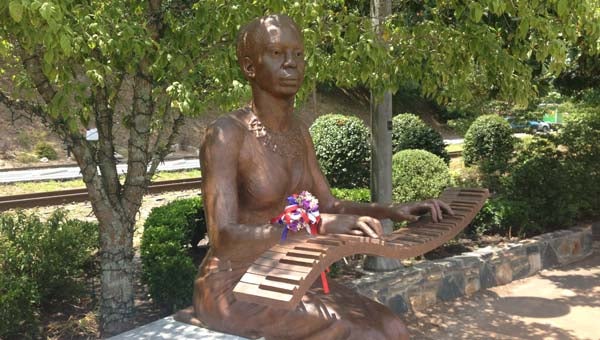Tryon reacts to new Nina Simone documentary
Published 10:00 pm Monday, August 3, 2015

The Netflix documentary directed by Liz Garbus was released on June 26 and focuses on Nina Simone’s rise to music popularity as well as her decline in health and personality in the last few decades of her life. Simone became famous during the Civil Rights Movement due to her radical views on segregation and the nature of her music hits as they pertained to the rights of African Americans during the 1960s. At her statue on Trade St. in downtown Tryon, a corsage was recently placed on Simone’s wrist. (Photo by Michael O’Hearn)
By Michael O’Hearn, Intern
A new documentary showcasing Tryon native and world-reknown singer, Nina Simone, was released in June by Netflix. Local figures in Tryon responded to the documentary by discussing the life of Simone.
The documentary, entitled “What Happened, Miss Simone?” and directed by Liz Garbus, details Simone’s early life in Tryon and her rise to popularity through a blending of jazz and classical music during the Civil Rights Movement.
Dr. Crys Armbrust, former professor at the University of South Carolina, is the executive director of the Nina Simone Project in Tryon. Armbrust reflected on Tryon’s place in music history as the place where Simone was born.
“My father, who was a pretty eminent musician himself, mentioned in passing conversation one day that Nina Simone was from Tryon. I didn’t believe him because, in most other cities and towns, that is a distinctive quality,” Armbrust said. “This one mile radius, Tryon, is the only place in the world that claims to be the birthplace of Nina Simone.”
Armbrust said he was amazed then to realize that Tryon did very little in recognition of Simone.
“I was stupefied that Simone’s name was not on every turn of Tryon, especially downtown,” Armbrust recalled. “And I said to my father, ‘I can address this.'”
Armbrust then set up the Nina Simone Project when he was the president of the Tryon Downtown Development Association, which he utilized to build a statue in Simone’s honor in downtown Tryon.
Armbrust mentioned that Lisa Simone Kelly, daughter of Nina Simone, was the body model for the Simone statue from the head down because both she and her mother had the same physical characteristics at the age in which the statue was molded.
Simone’s ashes, which were provided by Kelly, were enclosed in a second, heart-shaped bronze sculpture to be placed inside the Simone statue.
Armbrust helped director Liz Garbus put together “What Happened, Miss Simone?” by supplying local materials for use.
“Liz has become a good friend to me and I had a hand in making that film by providing all of the Tryon materials,” Armbrust said. “Jeff Lieberman also did another film on Simone and most of the filming was done at my house. Now, this may seem to suggest that I played the Nina field, which I have, but frankly my interest is the promotion of Nina Simone. I want as many people as possible working on her in TV, articles and film.”
Attempts to contact Simone’s family and the director of the documentary were made but no response came back before press deadline.
Lieberman brought his film, “The Amazing Nina Simone,” to Tryon on February 21, 2015, the same day as Simone’s birthday. The director from New York expressed his thoughts about Simone, which he wanted people to understand through his documentary.
“I think she (Simone) was certainly bold and extremely brave and took a lot of risks that a lot of artists were not taking at the time of the Civil Rights Movement,” Lieberman said. “I think Nina was unique in that she really did take a lot of chances and she wasn’t too concerned with the backlash she would receive and did end up receiving because she felt really strongly about the injustices that were going on in the U.S.”
Beau Menetre is one of the founders of the Polk County Film Initiative who helped director Jeff Lieberman bring his film to Tryon in February.
“My wife and I had known Nina Simone’s music for years but when we moved here four years ago we did not know this was the birthplace of Simone and we were pleasantly surprised,” Menetre said. “What I learned of Simone really came from people like Crys Armbrust and Jeff Lieberman and just my general interest in film and through my own research. I think she was one of the most talented artists who has ever lived.”
Simone’s rise to music fame was interesting to Lieberman, as she was never a singer like her siblings but a classical pianist.
“That was a natural progression for her. She wasn’t a singer growing up like her sisters and brother and she didn’t have a huge range or octaves but a unique sound and someone at a bar in Atlantic City discovered that,” Lieberman said. “She loved classical music and she was going to incorporate it throughout her life.”
According to Lieberman, Simone changed during the 60s due to a number of things going on in her life and nationwide, including the losses of people close to her and a change in the music industry.
“I saw the documentary on Netflix, too, and I believe they oversimplified it with the death of Martin Luther King, Jr. and the church bombing in Birmingham,” Lieberman said. “She lost a lot of people she was relying on to carry her through the system while she also felt the changing of the world’s musical tastes with the emergence of disco, pop, soul and R&B. I don’t think she ever got a break, either, as she was always busy touring and recording and being a mother and an icon.”
If Simone were still alive today, Lieberman said she would still be fighting for her civil rights in the midst of what has pulverized America today with events like Ferguson and the Charleston shooting happening in the last few years.
“People believe Simone hated America and that’s not true,” Lieberman said. “She wanted to change America because she thought we are the United States of America. The church bombing she experienced in ’63 in Birmingham is no different than the Charleston shooting so I think she would still be singing today. She wasn’t doing anything extraordinary besides demanding respect. That’s what I think makes her extraordinary.”





